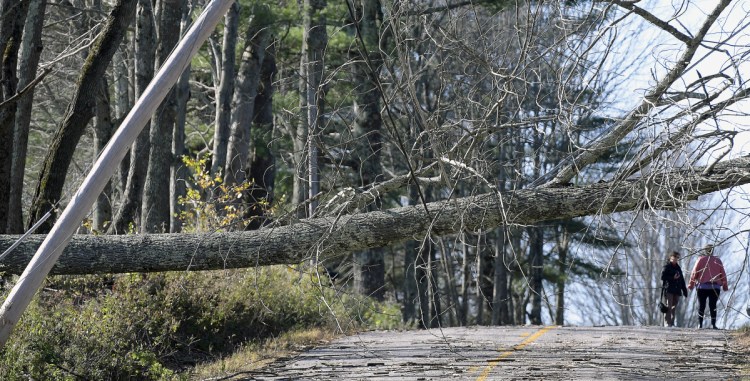When the high wind and rain blew through Litchfield in the early hours of Oct. 30, 2017, it didn’t seem so different from other storms that have rolled over Maine.
The power went out, but that didn’t worry the Christmans on Hallowell Road.
“We were able to get around,” Jana Christman said.
A tree had fallen across the road, but it was easy enough to drive through their pasture and take down some gates to get out onto the road. But when their daughter headed out for school toward Route 197 in the other direction, a tree was down there, too.
“We were pinned in the house for a day or so because of the big trees down,” Christman said Sunday, “until the crews could get out and move some stuff around.”
About five days earlier, heavy rain had fallen across the region, and even as that system was moving out, weather forecasters warned of a nor’easter that was on a path to hit Maine, bringing high wind and even more rain.
By the time the storm hit, it had grown in ways that were unexpected and hard to prepare for.
It brought heavy rain in some places and flash flooding. Strong wind blew down trees and power poles. More than a half million people in Maine were without power, some for more than a week. Schools, government offices and businesses were closed as people worked to restore electricity, clear roads and make repairs.
While forecasts had predicted when and where the storm would hit, people were not prepared for the power of the storm or what it would take to recover.
Even a year later, the influence of the storm is still being felt.
EARLY PREPARATIONS
On Friday, Kevin Elwell, director of Electric Distribution at Central Maine Power, had already spent hours preparing for the nor’easter that moved through the region this past Saturday.
“As part of our planning process, which we have been doing for almost a week, we remind ourselves that it’s the one-year anniversary, and whatever lessons we learned we take forward,” Elwell said.
As it happens, Saturday’s storm brought rain and snow and wind and some power outages, but nothing close to what happened a year ago.
In the days leading up to the 2017 storm, preparations were ramping up across the state.
“With any forecast, there’s uncertainty in what we’re seeing as we go days out,” John Jensenius, warning coordination meteorologist at the National Weather Service in Gray. “You don’t want to alarm people too far ahead of time because a lot of times these things don’t happen.”
It was an unusual storm. What was predicted to be a typical nor’easter ended up as something more, strengthened by moisture and energy from Philippe, a tropical storm in the Atlantic Ocean.
By Friday, the weather service was briefing emergency managers about the coming storm, which was expected to bring rain and wind with gusts up to 50 mph. Throughout the weekend, Weather Service advisories signaled conditions would be worse than initially expected.
Monday brought rain and around daybreak, a intense period of strong and damaging winds, fueled by the tropical system, blasted through the state.
“We ended up with gusts in the mountains and the foothills of 50 mph to 60 mph, and 60 mph to 70 mph on the coast,” he said.
Perhaps as significant as the speed of the winds was the direction from which they came.
“The wind was out of the southeast,” he said. “Most of the time, you’re looking at a north or northeast wind.”
That difference of direction, as well as the already rain-soaked ground, could have contributed the large number of trees that were uprooted in the storm.
Elwell said when the trees started falling, the company’s advanced metering infrastructure lit up indications where outages were happening.
“I saw it at about 5 o’clock at the morning, and it was colorful,” he said. At first, the impact looked typical, but as the day went on and outages topped 200,000 and 300,000.
“Then it started entering in areas we had never been before,” he said. That’s when outside resources started to be called in from across the northeast and eastern Canadian provinces.
At midday, the outages peaked.
Maine, he said is a challenging state to serve with electricity.
“We’re the most heavily forested state in the country, and we have a high level of ledge or rock for digging,” he said.
Setting poles in ledge is hard, and there are only so many specialized pieces of equipment that can dig holes for poles, and deploying them can take some time.
“What we can do is make the impact of those events less,” Elwell said, including using a pole with a larger diameter, which are more rugged, as well as using more covered conductors to make them more resilient.
At the same time, cutting the outage time is also a priority, he said.

Emma Christman, 17, helps her mother, Jana, fuel a generator in the shed Oct. 31, 2017, at their Litchfield home.
Technology has played a role in improving storm response.
Elwell said during the ice storm in 1998, finding help was not just a matter of making a single conference call to a mutual aid group, as is now the practice. Two decades ago, employees might spend hours flipping through paper directories and calling individual utilities.
Technology is also used in being able to remotely shut off power so the time it takes to make repairs can be shortened.
“There is a general consensus that more frequent, more intense storms are likely because of the climate we’re in right now,” Elwell said.
That’s part of the reason CMP is pursuing a plan to strengthen the infrastructure.
On the ground, the breadth of the storm’s devastation was sometimes hard to grasp.
Like the Christmans, many people were stuck at home, unable to get past downed trees and wires.
In Gardiner, the storm tore open the roof and ventilation system of the James A. Bragoli Memorial Gym, leaving a hole about five feet across that let in rain, covering the floor in about 2 inches of water. The damage closed the gym for about six months while repairs were made, Gardiner Area High School principal Chad Kempton said.
Across the region and in Litchfield, where the Christmans were stuck, fallen trees blocked many roads.
“In a big storm you expect the electricity to be impacted,” Rayna Leibovitz, who serves on the Litchfield Board of Selectmen, said. “The biggest problem was the number of trees the storm took down. The trees were across the roads and the power lines were embedded in the trees.”
Town officials were frustrated because CMP, which was focused on damage assessments and power restoration, couldn’t immediately send crews to de-energize the lines so that public works crews could clear the roads. And the only way first responders had of getting around town was often to drive out of Litchfield to get around blockages.
Leibovitz, who for years taught emergency preparedness for the Maine Emergency Management Agency, said her town is incredibly resilient.
As the power outages continued, the town opened up the Carrie Ricker School so that residents could come for a hot meal or a hot shower, and neighbors checked on neighbors.
LESSONS LEARNED
In the wake if the storm, state regulators have reviewed the actions of both Central Maine Power and Emera Maine, the power company that serves northern Maine.
In September, the Maine Public Utilities Commission concluded that both companies responded “reasonably” to the storm based on weather forecasts at the time. But both companies are required to file with the commission the steps they are taking to improve customer access to outage and restoration reporting by Dec. 1.
Communication has emerged as one of the most critical aspects.
At the state level, the Maine Emergency Management Agency held daily briefings in the days after the storm to update progress in restoration.
Susan Faloon, spokeswoman for MEMA, said in the wake of that storm and with the appointment in December of a new director, Suzanne J.M. Krauss, changes have come to that agency.
“We’ve rearranged our operations center so it works more efficiently,” Faloon said.
The agency has also been training with other state agencies in a variety of scenarios to understand what response is appropriate.
MEMA is also working with non-government agencies beyond utilities, because they play a role in getting critical services to state residents.
Following the concerns expressed by Litchfield officials and those in about a half-dozen other towns, the Kennebec County Emergency Management Agency and Central Maine Power are reviewing how they interact in a widespread power outage.
In March, the county EMA convened a meeting between local emergency responders and CMP to talk about their conflicting priorities.
The result is a plan that more clearly defines the lines of communication to hasten the process of shutting off power in downed lines so roads can be cleared.
“(The plan) may take people away from restoration work,” Sean Goodwin, director of Kennebec County EMA, said. “But there are times we need to have a road open more. There’s a process now on how they go about notifying CMP.”
At a community level, Leibovitz said the storm has prompted neighboring municipalities to talk about what resources they have and could share.
In Litchfield, the Christmans think about preparedness a year later.
“I’ve lived in Maine my entire life. So has my husband,” Jana Christman said. “The year we bought the house, we put in the generator because we knew this is what happens in Maine.”
They make sure they have lamp oil, candles and flashlights. They have water tubs for the horses and a woodstove for heat in case the furnace doesn’t run.
“We have talked about getting a larger generator so that it can run more of the house on it rather than just a few necessities,” Christman said.
“We all know what we need to do,” she said. “It’s just taking that final step to do it.”
Jessica Lowell — 621-5632
Twitter: @JLowellKJ
Copy the Story LinkSend questions/comments to the editors.




Success. Please wait for the page to reload. If the page does not reload within 5 seconds, please refresh the page.
Enter your email and password to access comments.
Hi, to comment on stories you must . This profile is in addition to your subscription and website login.
Already have a commenting profile? .
Invalid username/password.
Please check your email to confirm and complete your registration.
Only subscribers are eligible to post comments. Please subscribe or login first for digital access. Here’s why.
Use the form below to reset your password. When you've submitted your account email, we will send an email with a reset code.